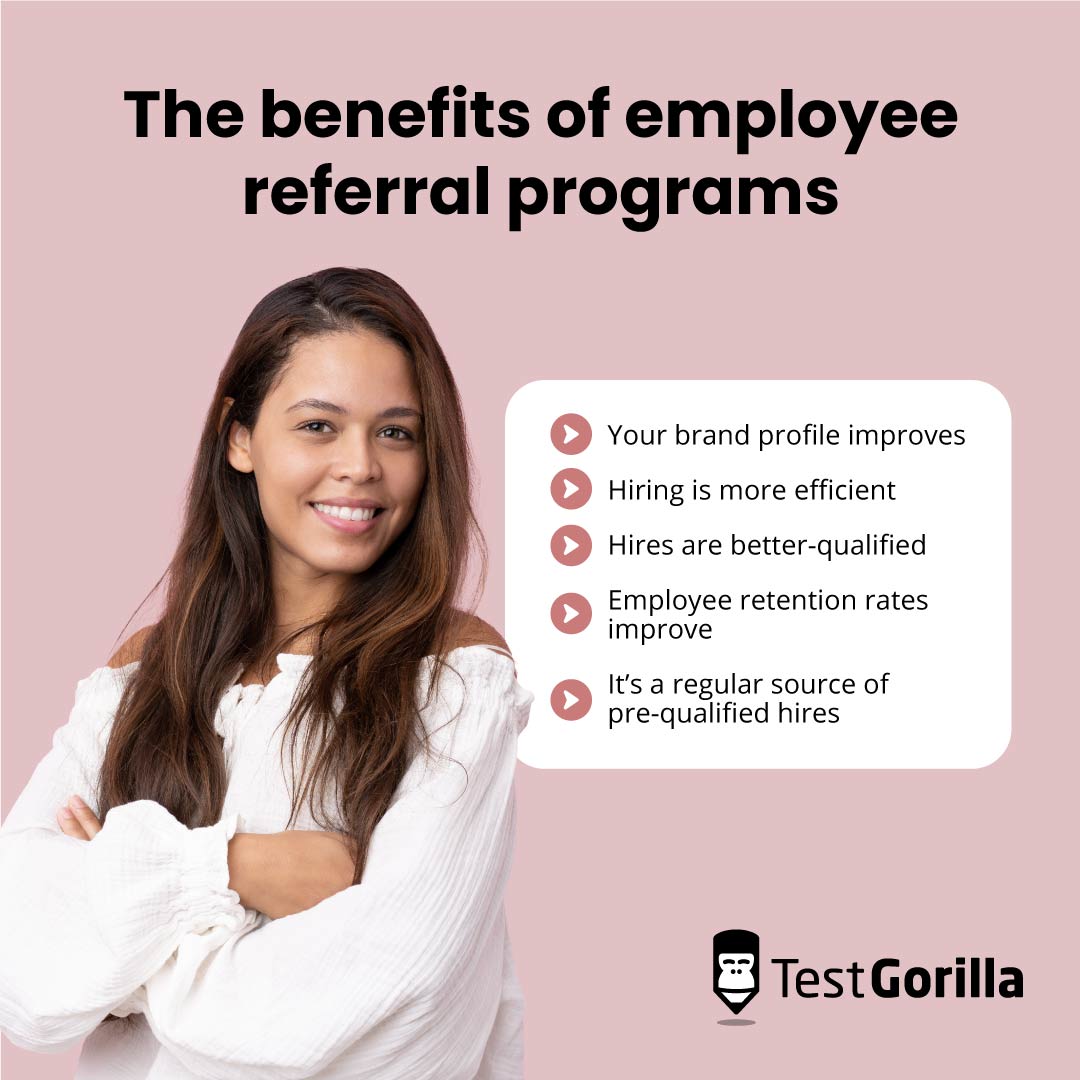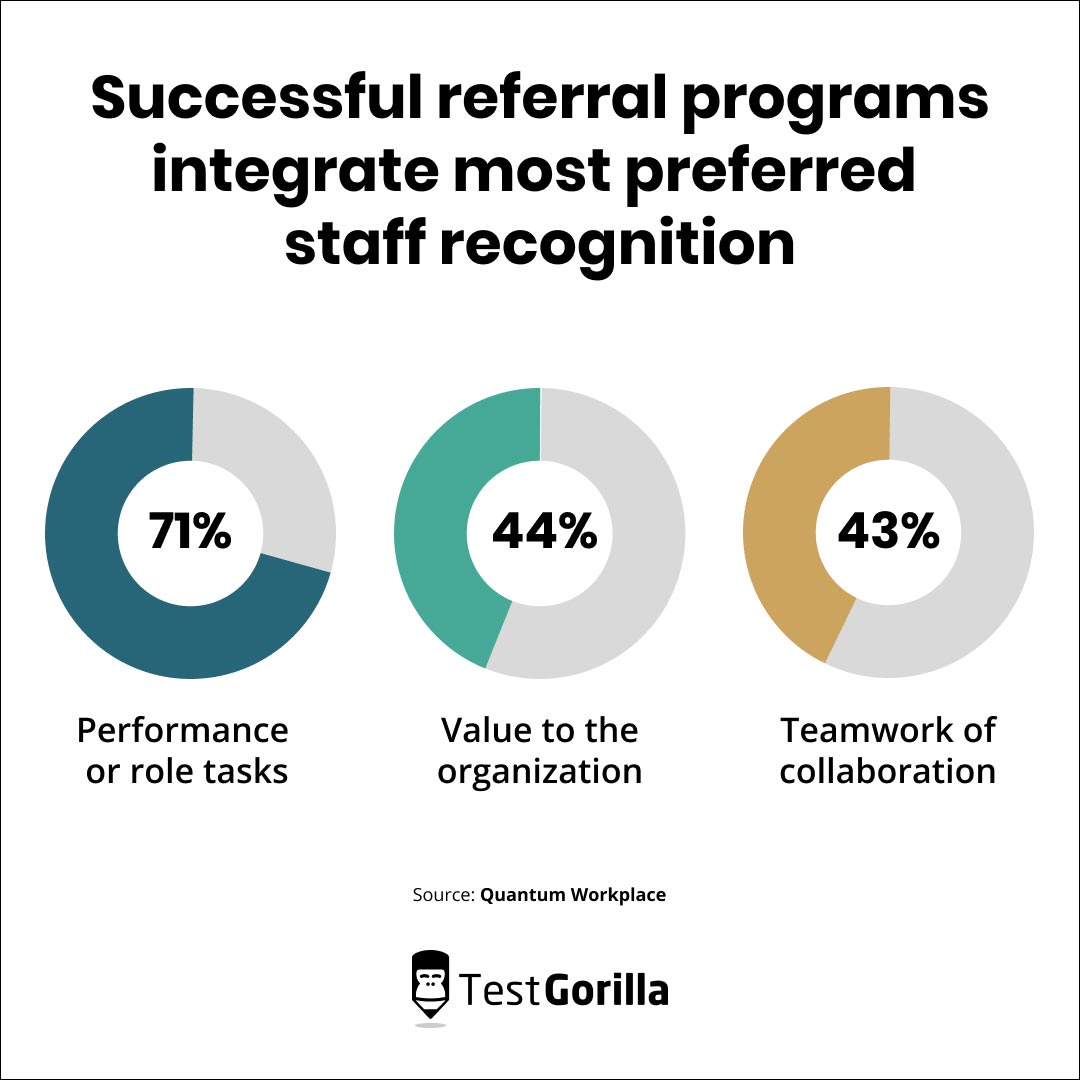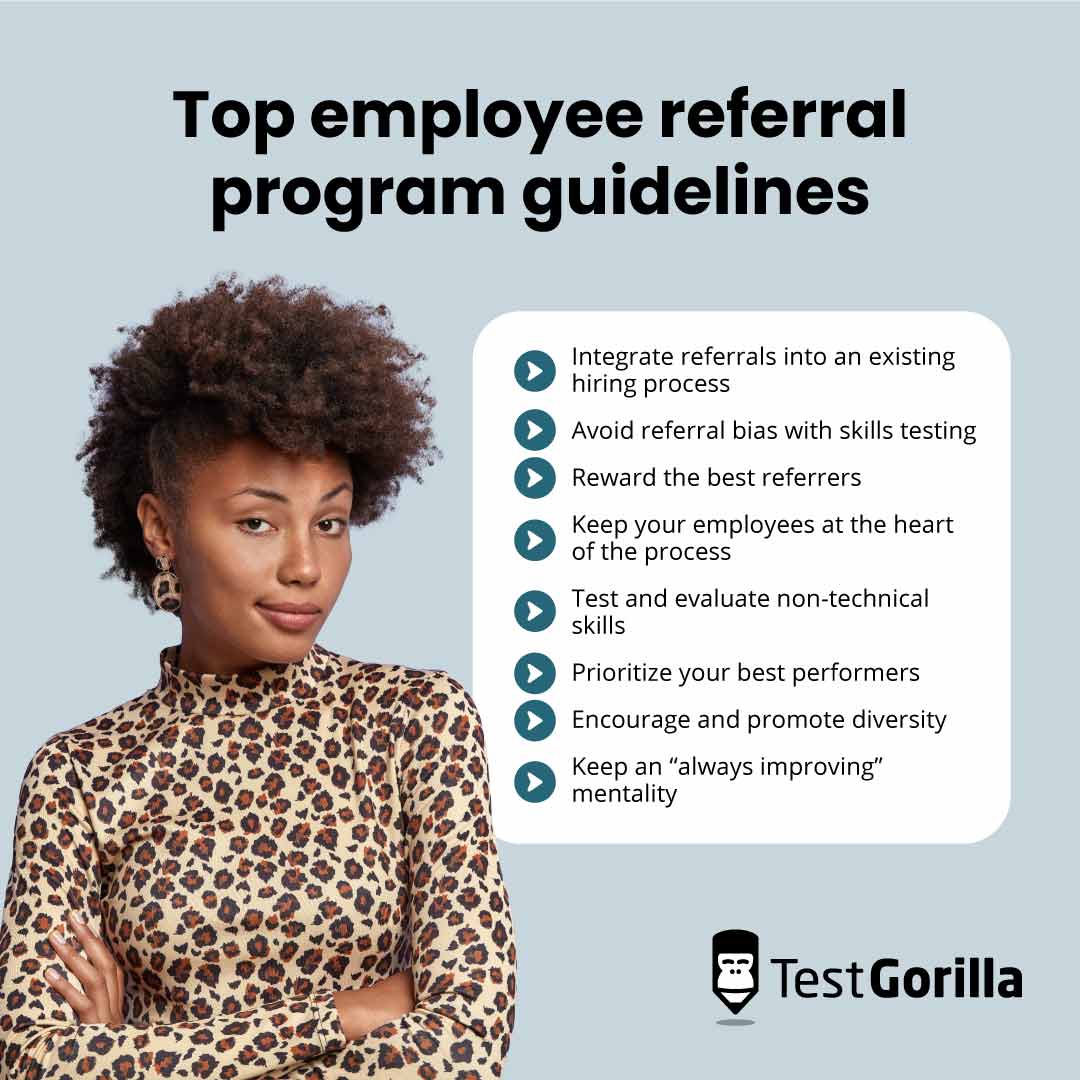Employee referral programs: How to leverage this talent acquisition strategy to recruit qualified candidates
As a recruiter, you're up against the clock and the budget to bring talented and enthusiastic professionals into your firm. However, you risk hiring people who are a poor fit for your company by rushing the process.
A good first step is to move toward a skills-based hiring model. But have you considered an employee referral program, too?
Referral systems help you harness your team’s professional network to recruit qualified, diverse candidates.
Used effectively, they shave time off your recruitment process, boost employee engagement, reduce hiring costs, and improve morale and culture add.
However, referral programs need proper planning for long-term success.
In this guide, we show you:
The benefits of this talent acquisition strategy
Tips for creating a referral system with your existing hiring plan
Companies with the best employee referral programs
Table of contents
- What is an employee referral program?
- Why are employee referral programs important?
- The benefits of employee referral programs
- 8 best practices for leveraging employee referral programs to acquire top talent
- 4 examples of companies succeeding with employee referral programs as a talent acquisition strategy
- Transform your hiring process with employee referral programs
- Sources
What is an employee referral program?
Through an employee referral program, you ask current employees to recommend qualified people they know to join your company, and in return, referrers receive a reward or cash bonus if their connections join the team.
For example, when hiring a project manager, you could incentivize your employees to refer someone who fits the PM role well, both in terms of skills and culture fit.
Research shows compensation and benefits for employee referral programs start at $100 and rise to $5,000 based on skill and seniority.[1]
The cost of hiring a $70,000 employee via an agency at a base rate of 15% is $10,500.[2] Based on the above figure, you could save at least $5,000 per hire.
Why are employee referral programs important?
An employee referral program is more than a talent acquisition trend; it’s a long-term strategy that helps employers find talent and improve retention rates.
Following the Great Resignation, employers need all the tools available to fight rising employee turnover.
Employee referral programs help by giving you a low-cost way to fill talent pools during staff shortages and budget crunches.
You pay your staff to help you hire, slimming down the recruitment funnel in exchange for incentives and bonuses. At the same time, your employees become more engaged with your company’s success – and they’re rewarded for it.
The benefits of employee referral programs
An effective employee referral program offers more than just financial benefits.
We split the long-term benefits into two categories below (for you and your staff).
Benefits for employers
Employers benefit from implementing referral programs because:
Your brand profile improves
Hiring is more efficient
Hires are better-qualified
Employee retention rates improve
It’s a regular source of pre-qualified hires
Your brand profile improves
There’s little effort required of staff to claim bonuses for successful referred candidates. Because of this, your brand appears generous to applicants.
Most employees, too, value an increase in benefits when filling out job applications.
For internal staff, your brand invests more in their knowledge and connections, and you show your people that you value their experience and insight.
This boosts morale and builds your image as a supportive, credible employer. Most importantly, you trust your staff's recommendations.
Again, this can be highly attractive to applicants looking for a positive candidate experience. Job seekers want to avoid red flags that suggest brands micromanage. Instead, referral programs show you’re willing to trust your own employees to help make hiring decisions.
Hiring is more efficient
Reducing time-to-hire is a big concern for most HR departments. When handling high-volume applications, cutting your hire time metrics is even more important.
However, by rushing, you risk reducing applicant quality and increasing employee turnover rates.
Research shows the average time-to-hire for companies in the US is around 36 days.[3] That's time you might not have to fill important roles.
Employee referral programs reduce your need to pre-qualify candidates or even post job openings. Candidates proceed to interviews without the need for you to sift through resumes (slowing down hiring efficiency).
Referring removes the need for time-consuming resume screening. You could reduce time-to-hire further with pre-employment skills testing, too.
Testing doesn’t undermine your employees’ recommendations. Instead, it improves the quality of your hiring automation.
Hires are better-qualified
You filter out potentially bad hires by designing a unique referral template. You're enabling staff to pre-qualify candidates, which cuts down HR’s already full workload.
Your employees won’t want to recommend people unsuitable for the role(s). They want to receive their bonus and retain good standing within your company.
Your prospects become even better qualified with hyper-focused skills testing, too.
For example, if your referral program template requests technical expertise, you could further test for communication skills and time management capabilities. This way, you hire more well-rounded, qualified candidates.
Referrals also help you recruit passive candidates. These hires might be open to a career move and additional benefits, but they’re not actively checking job boards or looking for work.
Employee retention rates improve
Employee referrals significantly enhance retention. Employees hired via referral programs are more likely to remain at their companies than those who arrive by other means. Their average employment duration is 38 months, which is significantly higher than the average retention duration of 22 months for non-referral hires.[4]
People referred to these positions typically trust those who refer them. It’s a positive experience because they:
Feel valued by you and the referrer
Are likely to remain with you for the long term
Have a familiar face during onboarding
The cycle continues. A referred employee may find the referral program appealing and stay with you to take advantage.
It’s a regular source of pre-qualified hires
With referral programs, you always have access to warmed-up, qualified applicants.
An effective employee referral bonus program keeps your talent pool thriving. You reduce the need to start new job recruitment drives and spend more time and money hiring.
Keeping your talent pool thriving with a learning and development culture ensures you have skilled employees with high internal mobility. Doing so creates a more capable and agile workforce.
Although employee referral candidates are pre-qualified, use talent assessment tests to find areas you can develop over time. For example, check for leadership development potential.
Consider setting up a leadership development plan you can bring referred hires into once they pass their interviews.
Benefits for employees
There are no specific drawbacks for staff taking part in referrals. They appeal to workers because:
Staff feel more important
Workplace morale improves
Participants feel they’ve “done some good”
Let’s explore these points.
Staff feel more important
With a successful employee referral program, you show staff that you value their ability to find qualified staff to join the team.
Research shows 44% of staff feel highly valued when they have a direct impact on their organizations:
On the other hand, lack of motivation through poor recognition can reduce productivity by 49% and work quality by 39%.
Workplace morale improves
Employees feel happier and more motivated when bonus incentives are achievable. Around 79% of millennials and Gen Zers would be more likely to stay in a workplace if benefits were to improve, too.
The bar for clearing a referral bonus is fairly low. Staff simply need to recommend people they know who fit your parameters.
There is pressure on their part to find someone that boosts their internal reputation, but the program is entirely optional. Staff feel more relaxed and are happier to enter programs on their terms.
Participants feel they’ve “done some good”
Referrals help staff feel they've helped someone in their network – someone who could be looking for open positions more worthy of their talents and experience.
It's a chance to earn "good karma" and boost morale while doing some good for your company and its culture.
8 best practices for leveraging employee referral programs to acquire top talent
Now that we’re clear on the benefits of an employee referral program, let’s explore how you can build an effective one for your company’s hiring needs.
Our top employee referral program guidelines
Practice | Explanation |
Integrate referrals into an existing hiring process | Don’t rush to remove existing processes – referral programs easily slide into recruitment strategies and shouldn’t be relied upon by themselves |
Avoid referral bias with skills testing | Trust referrer judgment, but ensure you have a safety net with talent assessment tests that prove applicant aptitude |
Reward the best referrers | Incentivize regular referrals to keep the talent pool filling with reliable, quality candidates |
Keep your employees at the heart of the process | Update referrers at every step of the recruitment process (within reason) to ensure they’re acknowledged |
Test and evaluate non-technical skills | Avoid guesswork and reduce resume reliance by testing for teamwork and emotional intelligence skills |
Prioritize your best performers | Reach out to top-performing staff for the first round of referrals (during testing) |
Encourage and promote diversity | Use referral programs to embrace inclusive hiring and to remove bias from the hiring process |
Keep an “always improving” mentality | Keep an open mind and be willing to change your process at any given moment |
1. Integrate referrals into an existing hiring process
Although replacing your existing hiring process with a referral program is tempting, don't be so hasty.
Always keep your recruitment best practices in place if they drive positive results.
It's short-sighted to replace your existing process with a referral system. Always ensure you have a regular stream of talent flowing into your company from multiple sources.
It’s also a good idea to keep clear numbers on where your hires come from and gradually increase the scope or reliance on referral programs, if this strategy works for you and your best hires are coming from referrals.
You can improve your quality of hire, too, with skills-based hiring. Testing for skills with a custom TestGorilla assessment reduces your reliance on resume screening and potentially harmful guesswork, which is one reason we recommend you work toward a recruitment system that blends skills-based testing with employee referrals.
You should also use other strategies, such as setting up a virtual job fair, to reach a broad audience outside your employee network.
2. Avoid referral bias with skills testing
When hiring via referrals, there is a risk employees are biased because they may be close friends with those they refer.
You want skilled team members, not employees who are fun at happy hours.
There are risks your participants might be biased in other ways, too.
Although you should trust your staff where possible, it’s wise to mitigate potential bias with safeguards.
One way to safeguard against bias is to balance your recruitment process with technical testing. For example, for a sales role, consider testing for customer service or Salesforce skills.
With this method, you are never purely taking the referrer's word. You're trusting their choices with an extra filter.
You could use results from these tests to see which referrers produce poor hires and who show signs of bias.
Consider creating an ironclad program based on the specific skills and experience required. You effectively refuse referrals unless they meet the exacting standards you set. This risks narrowing down the talent outreach but secures you against bias.
3. Reward the best referrers
Offer praise, recognition, and (where appropriate) rewards to the most successful referrers.
You could explore this through open messaging (e.g., social media, intranet forums or Slack channels), or you could do so privately and avoid showing favoritism. Open rewarding, however, encourages people to participate in the referral program.
Always ensure staff know programs are open to all without bias. There is a risk of workplace resentment if the same referrers continue to get high praise.
However, avoiding excessive workplace negativity is simple if you make your reward scope clear at the start of the program.
You could make your referral program known to the public and have it serve as part of your recruitment marketing strategy.
Keep in mind that it’s important to reward employees for quality referrals, not based on the number of referrals they submit.
4. Keep your employees at the heart of the process
People don’t only want to receive their bonus money at the end of the referral process. They often want to know they're positively impacting their workplace.
Be sure to reach out privately to staff involved in referral programs. Create checkpoints where you let your referrers know how their choices proceed.
You’re under no obligation to reveal how referred hires are performing. Simply let your referrers know what stage their choices are at in terms of their applications.
Doing so doesn't just appeal to people's needs for recognition but further shows referrers this is a process worth repeating.
Share some feedback privately with referrers if recommendations fail to meet your standards. You ensure future referrals are higher quality, and the best referrers repeat the process.
5. Test and evaluate non-technical skills
Testing for specific technical skills is important for removing bias from the hiring process. However, don’t forget to hire for “human” and interpersonal skills during referrals.
For example, just because a referral is technically proficient on their resume doesn’t mean they’re a good fit for your culture.
Therefore, consider testing for power skills. These are lucrative attributes that are “human” at their core:
Leadership skills
Time management capabilities
Emotional intelligence
Adaptability
Creativity and innovative thinking
Consider testing for critical thinking for fast-paced roles and problem-solving abilities in highly complex or creative positions.
Doing so ensures your referred hires are talented at what they do but also well-rounded and reliable. They're trustworthy enough to delegate solo work and assign group tasks.
Backing a referral program with a balance of power and technical skill tests helps you check a referee fits your company ethos. It ensures you’re not simply hiring Andy from accounting’s best friends.
6. Prioritize your best performers
Always reach out to staff who prove they are the best at what they do. You likely have performance management scoring to show who is the most efficient and works best under pressure.
Your best performers might not always know the best people to help fill other roles in your company.
However, it's good practice to start an employee referral program by contacting high-performing staff.
They're more likely to know which people in their networks best fit your company and ethos. What's more, the longer the tenure with your company, the more likely an employee understands your culture and standards. Therefore, it could be beneficial to prioritize their referrals first.
Naturally, it pays to be objective and fair. When testing an employee referral program, consider reaching out on this basis. Open the program up to all who meet eligibility requirements for the full rollout.
7. Encourage and promote diversity
Employee referral programs help to boost diversity and inclusion hiring (provided you allow them to).
You shouldn't insinuate one particular group of people has more chance of getting hired than any other. Instead, assure your staff you welcome diverse hires and focus on objectively measuring candidates’ skills rather than their pedigree.
For example, show referrers you rank recommended hires based on their technical skills and culture add rather than which university they attended or which company they worked for previously.
By leading on skill results, you reduce unconscious bias and thus encourage more referrals from a wider diversity of people. You broaden your potential talent pool even further.
Failure to address hiring discrimination through your employee referral program turns more people away from your program. You risk painting your company in a detrimental light, too.
8. Keep an “always improving” mentality
Regular editing of your employee referral bonus program is necessary. For example, your company might need to pivot with industry movements or change your hiring strategy depending on consumer demand.
You might wish to introduce new technologies, techniques, and metrics to enhance your approach (i.e., by using AI in talent acquisition).
It's healthy to keep an open mind about how your program changes over time. Inform referrers you welcome feedback and that the program evolves with the company and its customers' needs.
Feedback helps you make your program more diverse, mutually beneficial, and efficient at bringing the best talent on board.
Review the process multiple times a year or when you have new positions. Don't leave making changes to the last moment (like when you experience a slump and need a drastic hiring strategy makeover during times of economic downturn).
One last tip: Don't rely on methods such as referral programs if you’re trying to drastically change your company culture. Other avenues, such as external hiring and campus recruitment, are better suited for adding new perspectives to your organization.
4 examples of companies succeeding with employee referral programs as a talent acquisition strategy
Here are four employee referral program examples from companies that have tried, tested, and succeeded with talent acquisition programs.
Employee referral program ideas that work
Company | Summary |
Intel | Offered cash incentives for diversity hires |
Asked specific questions of their referrers to niche down applications | |
DigitalOcean | Matched referrer bonuses with charitable donations |
Booking.com | Offered cash incentives for bilingual hires |
1. Intel
Global tech giant Intel has one of the more interesting employee referral programs: It tackled a deep-seated issue and overhauled its hiring process.
The company promised a “double” reward for staff who introduced new employees considered “diverse.” At the time, this catered to veteran hires, women, and ethnic minorities.[5]
This twist on referrals enabled Intel to:
Raise awareness of its DE&I principles
Improve its brand profile
Appeal to diverse hires outside the referral program
However, tailoring a referral program in this way has its flaws. Setting diversity goals might prove unrealistic, so companies must carefully assess their cultures, industries, and workforces before setting arbitrary targets.
There’s also a risk of turning diversity hiring into a box-ticking exercise rather than legitimately addressing cultural problems.
Follow Intel's example, but focus on building a good company culture before looking deeper into diversity.
2. Google
It’s no surprise forward-thinking Google has dabbled in employee referral programs – its referral efforts boosted their hires by up to a third.
The company’s methodology was to ask specific questions of their referrers to ensure the people Google hired fit its needs.
For example, hiring managers might ask if referrers knew of any “coding experts in the San Francisco area.” Doing so encouraged staff to think carefully about looking for people who fit at least two specific categories: skills and location.
It’s a simple yet effective way to ensure hires through referral programs are good fits, and it matches perfectly with Google's accessible corporate identity.
3. DigitalOcean
DigitalOcean, the cloud hosting provider, used an employee referral system to boost brand appeal and morale. Its program matched staff contributions with charitable donations.
The brand’s method of rewarding employees brought onboard valuable applicants and raised its profile as a company that “does good.”
This program proved highly successful for DigitalOcean over the years, with 40% of the host's hires for 2017 arriving entirely from employee referrals.[6]
4. Booking.com
Leisure company Booking.com sought to promote the hiring of bilingual staff to help satisfy their growing international customer base.
To achieve this, they tailored an employee referral program that offered limitless recommendations and additional bonuses for those who recommended bilingual personnel.
The program helped the company achieve statistics similar to DigitalOcean, welcoming around four out of 10 total hires from referrals alone. The company boosted this further by even asking for referrals during the interview process.[7]
Transform your hiring process with employee referral programs
Employee referral programs are highly effective in engaging staff, and not just from a financial bonus perspective. They show staff their opinions and actions genuinely improve how their companies operate.
For you, as a hiring manager or recruiter, running an effective employee referral program policy:
Improves staff retention
Boosts the quality of applicants you hire
Keeps talent rolling into your business
Enhances employer branding for external hires and recruitment programs to come
When combined with a renewed focus on skills-based hiring, employee referral programs offer you the best of both worlds – low-cost, high-quality hires.
Of course, it’s wise to look at improving your talent acquisition strategy from other angles, too. For example, consider learning how recruiting automation can trim significant time and stress from your processes.
Before setting up any referral programs or automation strategies, it pays to build a firm skills assessment strategy (with help from the TestGorilla test library).
Sources
Riha, Danielle. (December 5, 2022). “What Is the Right Employee Referral Bonus Amount?”. Team Engine. Retrieved July 25, 2023. https://www.teamengine.io/blog/employee-referral-bonus-amount
Elliot, James. (February 2, 2023). “The True Cost of Hiring an Employee in 2023”. Toggl. Retrieved August 3, 2023. https://toggl.com/blog/cost-of-hiring-an-employee
“SHRM Customized Talent Acquisition Benchmarking Report”. (2017). Society for Human Resource Management. Retrieved July 25, 2023. https://www.shrm.org/ResourcesAndTools/business-solutions/Documents/Talent-Acquisition-Report-All-Industries-All-FTEs.pdf
Koster, Adam. (October 19, 2018). “How Employee Referrals Impact Retention”. iCIMS. Retrieved July 25, 2023. https://www.icims.com/blog/how-employee-referrals-impact-retention/
Mohan, Pavithra. (July 29, 2015). “Intel Will Award Double Referral Bonuses For Diverse Hires”. Fast Company. Retrieved July 25, 2023. https://www.fastcompany.com/3049179/intel-will-award-double-referral-bonuses-for-diverse-hires
“Driving Engagement in Workplace Philanthropy Through An Employee Referral Program”. (2021). Bright Funds Case Study: DigitalOcean. Retrieved July 25, 2023. https://hello.brightfunds.org/wp-content/uploads/DigitalOcean-Case-Study.pdf
Mosley, Megan. (April 25, 2023). “Top 10 Creative Employee Referral Program Examples [Engage Your Workforce]”. ReferralRock: Referral Marketing. Retrieved July 25, 2023. https://referralrock.com/blog/employee-referral-program-examples/
Related posts
You've scrolled this far
Why not try TestGorilla for free, and see what happens when you put skills first.
Latest posts
The best insights on HR and recruitment, delivered to your inbox.
Biweekly updates. No spam. Unsubscribe any time.

Skills tests to hire the best
Our screening tests identify the best candidates and make your hiring decisions faster, easier, and bias-free.
Free resources
A step-by-step blueprint that will help you maximize the benefits of skills-based hiring from faster time-to-hire to improved employee retention.
With our onboarding email templates, you'll reduce first-day jitters, boost confidence, and create a seamless experience for your new hires.
This handbook provides actionable insights, use cases, data, and tools to help you implement skills-based hiring for optimal success
A comprehensive guide packed with detailed strategies, timelines, and best practices — to help you build a seamless onboarding plan.
This in-depth guide includes tools, metrics, and a step-by-step plan for tracking and boosting your recruitment ROI.
Get all the essentials of HR in one place! This cheat sheet covers KPIs, roles, talent acquisition, compliance, performance management, and more to boost your HR expertise.
Onboarding employees can be a challenge. This checklist provides detailed best practices broken down by days, weeks, and months after joining.
Track all the critical calculations that contribute to your recruitment process and find out how to optimize them with this cheat sheet.

















